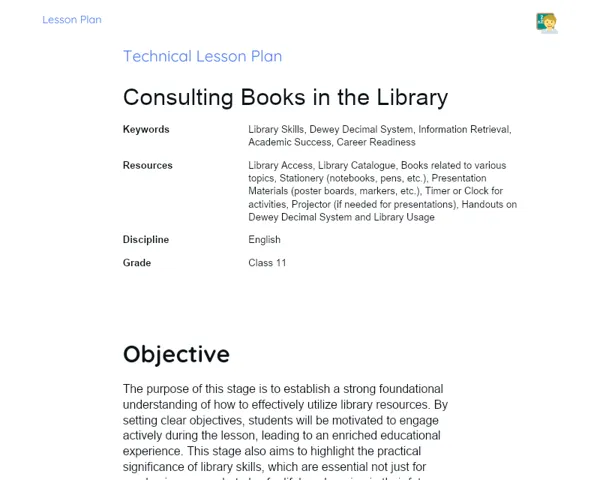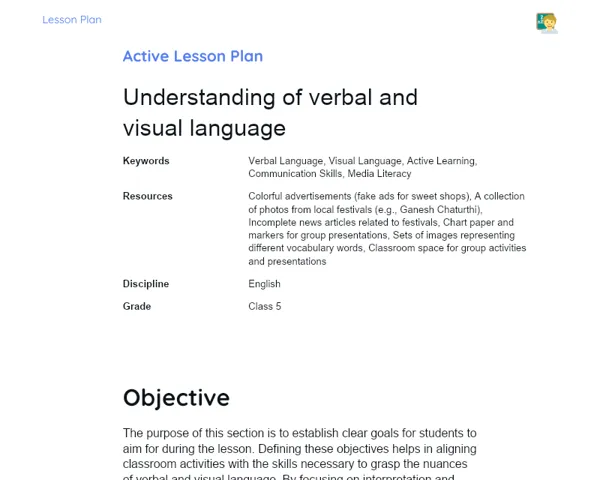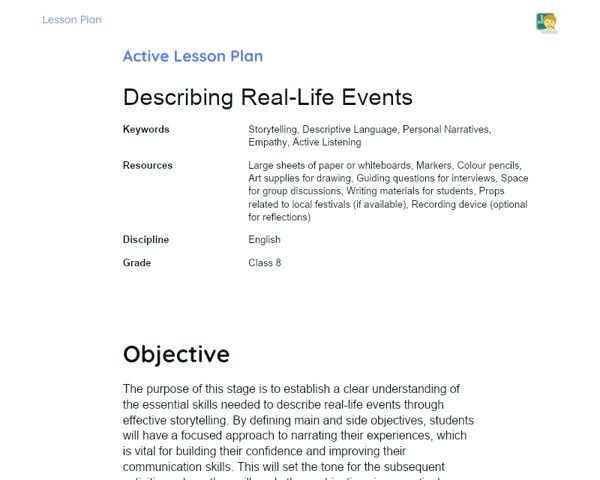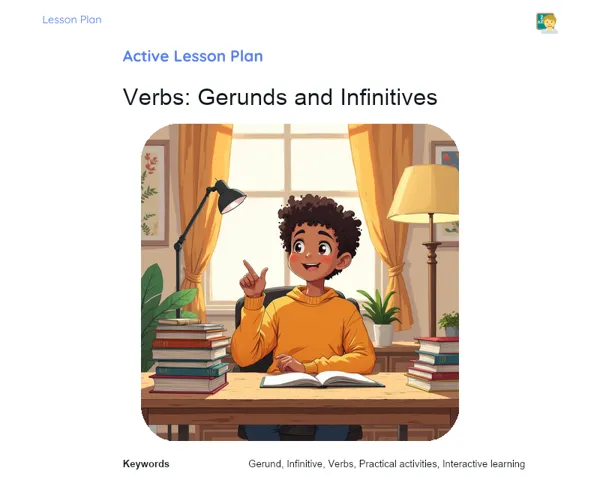Lesson Plan | Active Methodology | Possessive Pronouns
| Keywords | Possessive Pronouns, Interactive Activities, Effective Communication, Contextualization, Group Dynamics, English, Practical Learning, Student Engagement, Collaboration, Possession and Belonging |
| Necessary Materials | Cards with sentences containing possessive pronouns, Maps depicting various environments with highlighted objects and areas, Writing materials (papers, pens, pencils), Scripts for theatrical performances, Sufficient space for drama presentations |
Premises: This Active Lesson Plan assumes: a 100-minute class duration, prior student study both with the Book and the beginning of Project development, and that only one activity (among the three suggested) will be chosen to be carried out during the class, as each activity is designed to take up a large part of the available time.
Objective
Duration: (5 - 7 minutes)
This stage is crucial as it sets clear expectations for what students should learn by the end of the lesson. By outlining specific objectives, students can direct their learning efforts more efficiently. Here, the teacher should clarify not just the definition of possessive pronouns, but also how to use them aptly to convey possession in the right context.
Objective Utama:
1. Enable students to identify and use possessive pronouns correctly in simple sentences.
2. Enhance the ability to understand the concept of possession expressed through possessive pronouns in various contexts.
Objective Tambahan:
- Motivate active participation from students through engaging activities that reinforce the application of possessive pronouns.
Introduction
Duration: (15 - 20 minutes)
The introduction aims to capture students' attention and refresh their prior knowledge about possessive pronouns through relatable problem scenarios. By contextualizing the lesson, we illustrate the importance of the topic in real life, encouraging students to see possessive pronouns beyond mere grammar rules—as essential tools for effective communication.
Problem-Based Situation
1. Imagine you and your friends are gearing up for a birthday bash. Each one has different roles, like buying snacks, planning games, etc. How would you use possessive pronouns to explain these roles?
2. Think about a scenario where a football player lost his jersey. How might the coach use possessive pronouns to address this?
Contextualization
Possessive pronouns play a critical role in our everyday conversations, whether in formal writing or casual chats. They help us express ownership and association, like when we say 'my bike' or 'your home'. Also, mastering possessive pronouns is vital in academics and the workplace, as clear communication is key. Interestingly, discussing how British and American English differ can motivate students to delve deeper into the subject.
Development
Duration: (70 - 75 minutes)
This development phase is tailored to engage students actively and deepen their understanding of possessive pronouns through fun and interactive tasks. It aims to solidify their grasp of using possessive pronouns in diverse contexts, encouraging creativity, collaboration, and the practical application of their learning. Each proposed task seeks to engage students meaningfully, ensuring they can leverage their knowledge in memorable ways.
Activity Suggestions
It is recommended that only one of the suggested activities be carried out
Activity 1 - Detectives of Pronouns
> Duration: (60 - 70 minutes)
- Objective: Identify and modify possessive pronouns in diverse contexts to grasp their meaning and use.
- Description: Students will be grouped into teams of five and provided with cards that feature sentences containing possessive pronouns in English. Each sentence will come with a short story or situation. The team's task is to find and highlight the possessive pronoun in each sentence and then rewrite it by swapping the pronoun for an equivalent of another person (for instance, changing 'his' to 'her').
- Instructions:
-
Form groups of up to five students.
-
Hand out the sentence cards to each group.
-
Prompt them to find and highlight the possessive pronouns in the sentences.
-
Instruct students to rewrite each sentence, exchanging the pronoun for that of someone else.
-
Have each group present their rewritten sentences and explain the changes made.
Activity 2 - The Map of Possessives
> Duration: (60 - 70 minutes)
- Objective: Utilize possessive pronouns in visual contexts to enhance comprehension of possession and location.
- Description: In this task, groups will receive a 'map' depicting an area with different highlighted objects and locations. They will craft sentences using possessive pronouns to indicate ownership of each item or location. For example, on a map showcasing a school, library, and classroom, students might say, 'his book is in the library.'
- Instructions:
-
Split the class into groups of up to five students.
-
Distribute a 'map' to each group, featuring various highlighted objects and areas.
-
Ask them to formulate sentences using possessive pronouns to denote ownership or location of each item.
-
Each group will present their sentences, and the rest of the class will guess which object or place is being referred to.
Activity 3 - Pronoun Theater
> Duration: (60 - 70 minutes)
- Objective: Cultivate the ability to use possessive pronouns naturally and contextually while fostering creativity and teamwork skills.
- Description: Students will put together short theatrical performances based on situations requiring the use of possessive pronouns. Each group will write a script and enact it, ensuring proper pronoun usage. The focus will be on clearly and creatively expressing possession and belonging.
- Instructions:
-
Organize students into groups of up to five.
-
Inform them that they'll create and perform a brief play emphasizing possessive pronouns.
-
Each group will draft a script that includes a minimum of five distinct possessive pronouns.
-
Groups will practice their plays, ensuring correct pronoun application.
-
Finally, each group will present their play to the class.
Feedback
Duration: (15 - 20 minutes)
The aim of this feedback stage is to reinforce learning, allowing students to contemplate their insights and share experiences with peers. This not only solidifies their understanding of possessive pronouns but also nurtures communication and teamwork skills. Discussions help clarify misconceptions and foster learning from one another’s experiences, enriching the educational journey.
Group Discussion
Kick off the discussion by recapping the activities completed and ask students what insights they gained regarding possessive pronouns. Invite each group to share their findings and challenges faced during the activities. Encourage students to discuss how they applied possessive pronouns in various contexts and how it enhanced the clarity of possession in their sentences.
Key Questions
1. Which possessive pronouns did you find most challenging to identify, and why?
2. In what way can using possessive pronouns change the meaning of a sentence?
3. Was there any instance during the activities where the application of possessive pronouns was unclear? How did you resolve it?
Conclusion
Duration: (5 - 10 minutes)
The goal of this conclusion stage is to ensure that students clearly understand possessive pronouns, integrating practical learning with theoretical concepts. This reminder helps solidify the knowledge gained and showcases the relevance of the topic for everyday English communication. Additionally, it offers a chance to address any lingering questions and reaffirm the applicability of what they have learned.
Summary
To wrap up, the teacher should go over the key points discussed during the lesson, highlighting the identification and correct application of possessive pronouns in English. A summary of hands-on activities like 'Detectives of Pronouns,' 'The Map of Possessives,' and 'Pronoun Theater' should emphasize the creative approaches students took.
Theory Connection
It's essential to stress how these activities intertwined theory and practical application. The structured exercises enabled students to apply theoretical concepts in daily life situations, reinforcing their comprehension of possessive pronouns in real and imagined contexts, aiding retention of knowledge.
Closing
Finally, the teacher should underscore the importance of possessive pronouns in improving English communication, both formally and informally. Knowing how to use these pronouns correctly is vital for expressing ownership and belonging clearly and effectively—a fundamental skill across various contexts.



